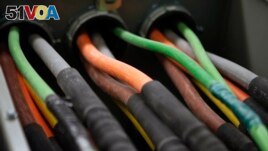03 January 2024
Japanese researchers say they have broken the world speed record for sending internet data.
The recent experiment involved sending data over fiber-optic lines enclosed inside cables. Fiber optic technology is currently the fastest way to transport, or transmit, internet data.
Fiber-optic cables use signals of light to send data over long distances. The fiber material is very thin, about one-tenth the thickness of a human hair.

FILE - Fiber optic cables are seen running into a server room at Intergate.Manhattan, a data center owned and developed by Sabey Data Center Properties, during a tour of the facility in lower Manhattan, in New York, March 20, 2013. (REUTERS/Mike Sega)
Fiber-optic technology was meant to replace an older internet transmission method that uses cables made mainly of copper wiring. This method can also carry data over the internet, but at much reduced speeds and capacity compared with fiber-optics.
A report released last year by the United Nations' International Telecommunication Union (ITU) suggested current worldwide internet data transmission is reaching full capacity levels.
The Japanese data transmission experiment used fiber-optic cables. But the engineers involved made some changes to the cables in an effort to greatly expand speed and capacity.
Such methods are known as multiplexing technologies. They aim to increase the amount and speed of internet data with existing transmission equipment. These technologies combine multiple communication signals into a single transmission line.
One multiplexing technology – called Wave Division Multiplexing (or WDM) – aims to increase the wavelength capacity within transmission cables. Another method – called Space Division Multiplexing (or SDM) – can involve increasing the size or number of fiber-optic centers, called cores.
Engineers from Japan's National Institute of Information and Communications Technology (NCIT) led the researchers who carried out the experiment. The tests measured speeds in petabits. One petabit equals 1 million gigabits.
The record transmission demonstrated a data transmission capacity of 22.9 petabits per second in a single fiber-optic cable. The previous record for data transmission was 10.66 petabits per second, set by the same team at NCIT.
Major progress has been made in recent years in internet data transmission speeds. In October 2022, an international group of researchers announced they had broken the world record. That team reported they had reached a test rate of 1.8 petabits per second using a single optical cable.
Results of the Japanese experiment were officially presented in a paper released at the 49th European Conference on Optical Communications in October. The team said it was able to beat the previous record by a large amount using new methods to expand and combine different WDM and SDM elements.
The method used a fiber-optic cable that contained 38 cores. The researchers said expanding the number of cores resulted in an "increased number of optical paths" for high-speed data transmission.
One researcher was Chigo Okonkwo of Eindhoven University of Technology in the Netherlands. He told the country's NL Times the rate of 22.9 petabits per second represented "about 20 times the global internet traffic per second." Okonkwo also noted the speed is about 229 times the total capacity of the kinds of fiber-optic cables currently in use today.
Worldwide, the estimated average internet data transmission speed in 2023 was about 46.8 megabits per second, international research service Statista reports. The rate reached 118.7 megabits per second in Western Europe, while Northern Africa had the lowest estimated rate at 9.8, Statista said.
The American-based Pew Research Center studies internet data transmission rates across the United States. Pew reports the fastest current data transmission method available in the U.S. – called Fiber to Home – is about 10 gigabits per second. This amount is equal to about 10,000 megabits per second.
Most Americans receive much slower data transmission rates, an average of just under 50 megabits per second. Pew estimates Fiber to Home service only accounts for about 20 percent of the U.S. internet service market.
The NCIT team described its latest test results as "a major step toward the realization of future ultra-large capacity optical communication networks." But in order to reach this goal, the team said its current methods must be further perfected.
For example, the researchers pointed to one major issue that could delay future deployments of its super-fast fiber-optic system. This will be the need to complete "significant upgrades" to current telecommunication hardware systems in order to support the new cable technologies.
I'm Bryan Lynn.
The Associated Press and Reuters reported this story. Bryan Lynn adapted the reports for VOA Learning English.
_________________________________________
Words in This Story
fiber optics – n. the use of very thin glass or plastic wires through which light can travel to carry data, especially for internet and computer applications
cable – n. a set of wires covered by plastic coverings
capacity – n. the total amount of something that can be produced or contained
wavelength – n. the distance between two waves of energy
upgrade – n. a piece of equipment or software that improves the quality or usefulness of a computer or machine